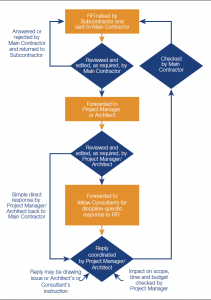Complete Guide to Construction RFI (+ Best Practices)
Construction projects are complex by nature. To be completed successfully, safely, and on time, the multitude of moving pieces (and the various people or companies who will play a role in delivering each one) must all be synced up. Stakeholders need to be on the same page and aware of how every part of the project will unfold.
But it’s nearly impossible to create a perfect construction project plan at the onset of the job. Even if you’re confident that you’re accounting for the full scope of work involved in the project, there will inevitably be changing variables during the planning, bidding, and building phases that will drive a change in your plan.
A Request for Information (RFI) document is used to keep these projects moving in a cost-effective and time-efficient manner. RFIs request key information from design and engineering professionals needed to flesh out project variables that have come up since the original bid or contract was drawn up.
In essence, the RFI is a communication vehicle for the dynamic planning and decision making that must go into completing a complex and expensive construction project.
Let’s dive deeper into how construction RFIs are used in the industry. Here we include details on where they tend to get contentious and break down the anatomy of an RFI. We’ll also explain how construction software can be instrumental in streamlining the RFI process in your construction company.
What is a construction RFI?
A construction Request for Information (RFI) is a document used to share and further scope out project details amongst design, construction, and engineering companies and professionals.
In short, an RFI is a written communication that is used (often by a contractor or subcontractor) to gather supplemental information during the course of a project or job. The information within the RFI is information that wasn’t initially included in the scope of the construction contract.
RFIs are also used to:
- Get more detail surrounding aspects of a project that cannot be easily inferred from the original contracted documents
- Clarify aspects of the project
- Make substitutions where needed
RFIs are often used in conjunction with other documents, including:
- Request for Proposal (RFP)
- Request for Tender (RFT)
- Request for Quotation (RFQ)
For those who learn better with visuals, you can check out the video below. This will give you some additional information about what RFI’s are and how they work.
Types of construction RFI
There is a huge variety in the types of RFI. Most organizations recognize around a dozen different classifications. Below you fill find the most commonly accepted ones, with a brief definition of what each entails and/or its purpose. Some have been combined, due to their similarity.
Design Change
These are some of the most diverse types of RFI. A design change be contentious it its very nature, as they can cause time-consuming workflow changes. While a change can be requested for any reason, the manner of presentation is important. Professionalism and respect are paramount and can turn this into a more pleasant experience for all.
Design Clarification/Incomplete Plans/Specs
The simpler cousin of the previous, these RFI’s often take little time. These are often requests for simplification or further explanation of how a project is structured or intended to take shape. This can be clarifying Specs that are poorly labeled or double-checking confusing information. A quick RFI response here is possible with a clear request of what is being asked. These fill information gaps, and can often see a timely response when done well.
Materials Change
Oftentimes workers and coordinators have a strong understanding of material science. Therefore, they are well-placed to make materials recommendations to engineering, management, and other project teams and team members. These are best done early in teh construction phase, so as to ease project disruption
Time and Phasing
Much like materials, those on the ground often know how long something may take. These can also seek to change the construction order and process. Explaining reasoning, such as a desire to speed up the project or improve conditions, can greatly improve these RFIs/ Taking these seriously can improve timeframe and reduce the amount of time wasted by using the building process experience of those implementing the designs.
Site Conditions
These RFIs have a strong focus on improving or altering conditions for those on the ground. This can be for workflow efficiency, safety, or quality of life. The burden is on those on the receiving end of the construction RFI process to take these very seriously.
Design or Construction Coordination
These RFIs often focus on logistical organization. This may be related to conditions, timing, workflow, and safety. Good documentation of these can make problem solving far easier
Value Engineering
Another section of worker insight, these RFI’s seek to enhance quality, reduce cost, or make the process more efficient based on the experience of those on the ground.
Utility Conflict
Workers may notice some form of utility, such as water lines, interrupting progress. These inform team members and may suggest or request methods for subversion or removal.
Constructability Issues
Very simply, these deal with perceived issues of implementation. Transferring design from concept to reality may not always be as possible as once thought.
Why do construction professionals send RFIs?
A construction RFI includes varying information specific to the job and the details a contractor needs to secure to move forward. Here’s a look at all the elements that could potentially be included in the anatomy of a construction RFI.
Clarifying or Changing Design Elements or Conflicts
An RFI can be used by a contractor to clarify design elements. Another use is to ask a question pertaining to how to approach a design flaw or conflict that has arisen during the course of bidding (or even starting) a project.
If the initial plans are incomplete, or the contractor needs more information to move forward on the job, the contractor will use the RFI to pose questions to architects or engineers on the project. This team will then explore the scope and justify changes if needed.
Requesting Substitutions in Materials or Accounting for Variables in Sites
An RFI may also be used when circumstances within a project change, such as planned resources or materials (originally included in the plan) not being available, or changing in price substantially. The RFI can be used to communicate the issue and suggest viable substitutions for clients, engineering, and stakeholder buy-in.
Additionally, it’s possible that a job site may introduce variables that need to be further addressed in order to proceed safely or on budget. An RFI can be appropriately used in this scenario as well.
Accounting for Issues in Constructability
There are some instances when issues in constructability arise. This is often due to the design itself or the nature of the job site and its variables. In these cases, an RFI can be used to outline the issue and ask for more details on how to proceed given the newly discovered issues.
How To Write an RFI
RFIs can be used in the construction industry to facilitate communication and expedite decision-making in several different instances. In order to be efficient, RFIs all follow the same basic format and flow of information.
Here’s a closer look at RFI best practices.

Lead with a Question
It is best to begin an RFI with the question that the contractor needs to be addressed. Because RFIs flow amongst multiple parts of a construction project, the wording should be concise, clear, and leave very little room for confusion.
Don’t assume that a designer or engineer will understand what you need from them if you state a problem rather than ask a question. Be direct and use a question mark.
Build Context Surrounding the Question or Need
Once the question is clearly stated and punctuated, it’s necessary to build context around why the question is being asked in the first place. Make sure your language is clear, easy to understand, and free of as much jargon as possible.
The person receiving your RFI may not understand the information in the same manner as you’d share it with someone on the job site. It’s important to make sure it’s easy for anyone to understand what is being asked and why.
Provide Visuals
Once you’ve asked the question and built context around why you’re asking for more information, it’s also helpful to include visuals to illustrate the issue or support your question with drawings, pictures, sketches, or videos.
Suggest a Solution
Finally, an RFI can also include your take on the matter. You should feel free to suggest a solution from your standpoint. Making a recommendation from the get-go can help move the resolution along more quickly.
Instances Where an RFI Should Not Be Used
The RFI has multiple uses within the construction, design, and engineering worlds. However, its overall purpose is fairly universal to gathering supplemental information or project details. An RFI should NOT be used, however, in the following instances:
- Routine communication during the course of a project
- Adding incremental design or engineering elements that should have been accounted for in the initial planning and bidding
- Sharing safety plans or protocols
- Submitting scheduling plans
- Seeking approval on changes to the means and methods of a project
- Providing general commentary on a project
- As a replacement for verbal communication or instruction on a project or job site
When a Construction RFI Can Become Contentious
A construction RFI is simply a communication document used to hone project details. This ensures that each job is completed correctly, on time, and on budget. Unfortunately, the intentions behind the use of this document have become somewhat of a point of contention in the construction industry.
An RFI is used to explore solutions for previously unknown factors in a project or modify the design and engineering plans that need closer examination or substitutions. In this sense, you use the RFI to facilitate decisions and changes to ensure successful completion of the project. It’s also used to pinpoint and solve design flaws.
Unfortunately, the RFI is often given a wary eye in the industry. It can be seen as a way to linger over the job by drawing out the project or trying to increase fees and spending on design and engineering elements of the project. It is also seen as a deliberate attempt to create a paper trail to validate delays or increases in project spending.
The true role of the RFI, though, is to facilitate communication that enhances a project by accounting for every detail conceivable as early in the project as possible.
Streamlining the RFI Process with Construction Management Software
Many construction companies are now leveraging the powerful tools in construction management software. The purpose is to facilitate and track their project plans and manage all the elements of their projects and business in one centralized system.
Construction software reviews from TrustRadius users frequently reference the RFI tools included in most design and project-management oriented solutions. They convey that software tools make the RFI process much smoother and easier to track along with other important aspects of a construction project.
Each RFI submitted during the course of a project typically costs $1000, and while the size and scope of the project will ultimately determine the costs involved in the RFI process, there are usually somewhere between 15 and 20 RFIs submitted in a $1million project. RFI costs are accumulated through a combination administrative and professional activities. Therefore, streamlining the administrative side of RFIs using construction software can often help minimize admin costs.
Using reviews from other construction companies like yours – who share similar project needs regarding planning and documentation and have a similar administrative capacity – can help you understand where construction management software can help you streamline the RFI process.
Reviews also help you understand the functionality of different systems. You can review how well they’ll fulfill your construction business needs and budget. This level of research ensures that you’re choosing a solution that will truly work for your company and deliver the best value for the investment.
To begin your search for the right tools for your RFI needs, check out tools like Procore, Newforma Project Center, PlanGrid, NoteVault, or others.
Was this helpful?

Looking for your next construction software? Start by reading 100% authentic reviews from users just like you.
